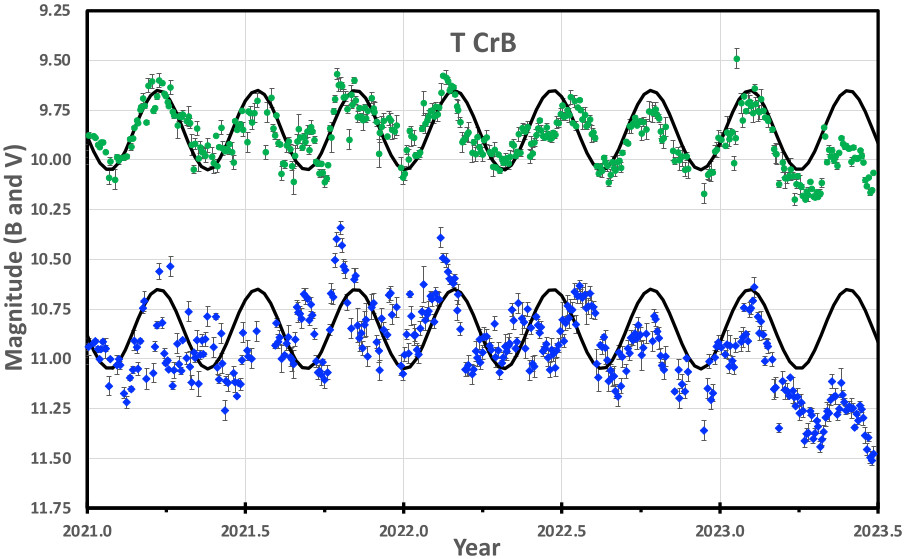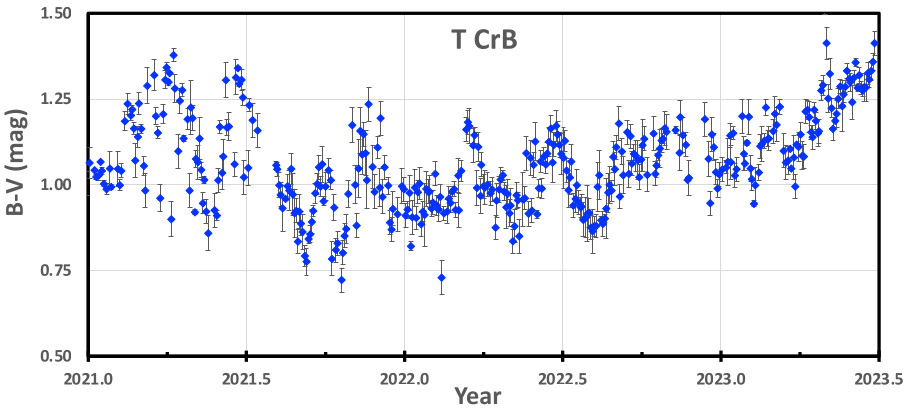AAVSO webinar

"Recurrent Nova T CrB Coming Soon to a Sky Near You!"
Join this special broadcast presented by Dr. Brad Schaefer, and brought to you by the AAVSO Cataclysmic Variables Section! Dr. Schaefer will discuss the history of this famous recurrent nova, the latest research into its unusual behavior, and the expected details of its imminent eruption. He will also talk about how amateurs can contribute to the study of this historic event, as well as the ongoing work on other recurrent novae. After the talk, Dr. Schaefer will remain available for a Q&A session.
Dr. Brad Schaefer, Professor Emeritus of Physics and Astronomy at LSU, is a renowned astronomer who contributes across many areas including supernova cosmology, novae, recurrent novae, gamma ray bursts, solar system astronomy, and the history of astronomy. He is also a long-time friend and supporter of both the amateur astronomer community and the AAVSO. You can learn more about Dr. Shaefer's work on his LSU faculty page.
September 9 @ 18:00 UT (2 p.m. ET)
Recurrent nova T CrB has just started its Pre‑eruption Dip in March/April 2023, so the eruption should occur around 2024.4±0.3
Authors: B. E. Schaefer (Louisiana State Univ.), B. Kloppenborg (AAVSO), E. O. Waagen (AAVSO), and the AAVSO observers
T Coronae Borealis (T CrB) is a famous recurrent nova with known eruptions in the years 1217, 1787, 1866, and 1946. Many workers have realized that the rise in brightness from its low state (1954.5 to 2015.0) to its high state (2015.0 to the present) is a precursor and harbinger for an upcoming eruption around 2025.5±1.3 or so (Munari et al. 2016; Schaefer 2023). A distinct and under-appreciated close-up harbinger is the unique and mysterious Pre-eruption Dip (Schaefer 2023). The Dip in 1945-1946 started around 1945.0 (1.1±0.3 years before the 1946 eruption), with the B-band magnitude fading from near 10.5 to 12.0 mag, while the V-band magnitude faded from around 9.8 to 12.3 mag. This fading ended abruptly with the nova eruption.
In anticipation of the start of this Pre-eruption Dip, we have been frequently monitoring the up-to-date light curve as collected into the AAVSO International Database. The AAVSO B and V band light curves from 2021.0 to present, with 2-day binning, for 4330 B-band mags and 12734 V-band mags, all with CCD photometry, are linked below. The normal light curve since 2016 shows the usual ellipsoidal modulation, with a full amplitude of ~0.4 mag for a sinewave at half the orbital period. The light curve shows variations about this average curve on all time scales, with larger variations in the B-band than in the V-band, all arising from ordinary flickering always present since 1867. Starting around 2023.25, T CrB shows a systematic fade from its long-time ellipsoidal variations. This fading is far outside of any historic variations since 2016. The fading in the blue was 0.4 mag in 2023.3 to 0.8 mag in 2023.5. The fading in the V-band was 0.25 mag in 2023.3, and 0.35 mag in 2023.5. The fading in the R and I bands are substantially smaller. This color dependency in the fading is consistent with increasing dust absorption, for a scenario featuring a recently discrete mass ejection in which dust formation occurs (much like for R CrB stars).
So the T CrB Pre-eruption Dip has already started in March/April of this year. If the Dip in 2023 is similar in timing to that in 1945, then the primary eruption should occur roughly 1.1±0.3 years later, or in 2024.4±0.3. This prediction is substantially improved over the prior predictions based only on the 2015 rise to the high-state. Still, possible deviations from the behavior in 1946 could create an early or a late eruption.
This announcement of the start of the Dip and the prediction of the eruption date (2024.4±0.3) will hopefully be of use for researchers for making proposals with a wide variety of telescopes. Further, this serves as advance notice to take all needed pre-eruption baselines, for example obtaining infrared fluxes and background nebulosity images over a wide field for later light echo detections. And it is not too late to try to understand the pre-eruption high-state, with it still being unclear whether the increased luminosity comes from increased accretion or from nuclear burning on the white dwarf. For observations before the upcoming eruption, we particularly point to U-band photometry, UV spectrophotometry, and spectral line profiles, all for measuring the energetic physical mechanism of the Pre-eruption Dip, while long-running infrared photometry might detect dust formation.

FIGURE 1. AAVSO B and V light curve for T CrB 2021.0--2023.5
This plot has 4330 Johnson B-band magnitudes (blue diamonds) and 12,734 Johnson V-band magnitudes (green diamonds) all with CCD cameras from 2021.0--2023.5, all binned into 2 day time bins. The usual ellipsoidal modulations (~0.4 mag full-amplitude as a sinewave at half the orbital period) are shown as the thick black curves, one for each of the bands. The variations on all time-scales around the ellipsoidal light curves are normal for T CrB (even back to 1867), with these flickering being larger in the B-band. The point of this plot is to see that the T CrB brightness has been systematically fading from it long time average. This is most prominent in the B-band, looking at how the observed light curve is falling off from the long-time average light curve, ever since 2023.25 or so. The fading is greatly more than any historic occurence (other than the 1945 Pre-eruption Dip), with this being far past measurement errors or any prior flickering/variability. In the last two weeks, the falloff has been at an accelerated rate of 0.18 mags in 14 days. Currently, T CrB is 0.8 mag fainter than expected in the B-band, and 0.35 mag fainter than expected in the V-band. This plot proves that T CrB is now well into its long expected Pre-eruption Dip, having started sometime around the end of March 2023.

FIGURE 2. AAVSO B-V measures for T CrB 2021.0--2023.5
The dimming of T CrB is faster in the B than in the V (see Figure 1). This can be represented by this plot of B-V from 2021.0--2023.5. Before 2023.25, T CrB's color fluctuates around B-V=1.05, with the variations being normal and usually tied to the ellipsoidal cycle. But after 2023.25, the B-V systematically rises from 1.08 to 1.41 in just a quarter of a year. The AAVSO light curves for R and I bands also show the Pre-eruption Dip, but only at a substantially smaller fade rate. This reddening in colors (greatest in B, substantial in V, small in R and I) is characteristic of dust extinction. So the point of this plot is to show that the dimming from the Pre-eruption Dip is greatest in the B-band, and diminishes towards the redder bands.

FIGURE 3. Pre-eruption Dip of T CrB around 1945
Back immediately before the 1946 eruption, T CrB suffered a unique and mysterious dimming. In both B and V, the star gradually started fading, had an accelerated fading, some sort of a minimum for maybe half a year, and then had the regular (thermonuclear) eruption rise suddenly out of this Pre-eruption Dip. The fading (from immediately before the Dip to the depths of the Dip) was roughly 1.5 mag in the B and 2.5 mag in the V. The V Dip faded fainter than the faintest ever observed, and the V light is almost entirely from the red giant companion. There is no known mechanism by which the red giant companion can suddenly fade by so large an amount, much less by fading far below its faintest level. So the dimming must be extrinsic to the red giant, and this can only mean by dust which somehow comes into the line-of-sight. However this dust is formed, this plot of the 1945 Pre-eruption Dip is what drives our expectation for a Pre-eruption Dip starting around 2023 for the upcoming eruption. This plot is what shows the timing in 1945, which provides our best guidance for the upcoming event in 2023 and 2024. We see that the start of the Pre-eruption Dip is uncertain, but appears sometime like 1945.0 with an uncertainty of 0.3 years or so. With the eruption flaring in 1946.1, we expect that the eruption starts 1.1±0.3 years after the start of the Pre-eruption Dip.

